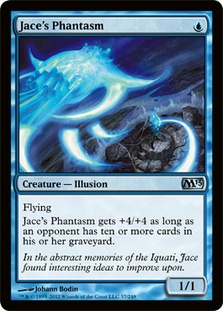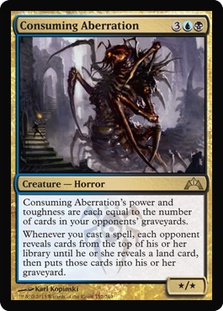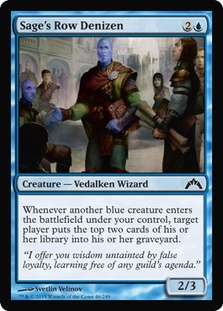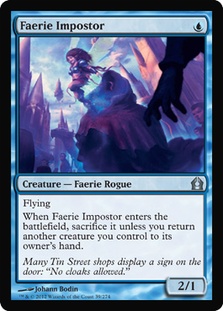Sometimes I feel like I’m losing my mind, like it’s drifting away and I’m returning to an ignorant, base form. The color of the world loses its contrast, and I pass into a purgatorial void. I would be frightened or disturbed, but at what point do I lose the faculty to care?

Milling is one of the most popular alternate win conditions in Magic. The flavorful path to forgetfulness, ignorance, and madness is an attractive option for many spellslingers. Unlike normal Magic, where your opponent spins down a die to track your progress, you can literally watch their life slip away card by card. Pretty fun, right?
When House Dimir first sidled into the Magic canon, mill started to become a mainstream idea with dedicated support for any player willing to commit to the all-in plan of sluicing away your opponent’s library. In fact, when I first started playing Magic seven years ago, the first deck I called my own was a Dimir precon that I bought while overseas. As such, I thought that milling was the primary way to win a game of Magic.
The face of mill has changed recently. No longer does a deck have to be wholly loyal to the proposition of milling; now, one can simply include a few cards in a control shell as a means to actually win the game. Nephalia Drownyard, Jace, Memory Adept, and Sands of Delirium are all one-card engines that let you void your opponent’s memory in a tidy, self-supporting package.
For a prospective mage who loves being on the mill plan, these options can be somewhat…unsatisfying. Sure, you get to hear your opponents use single digits when referring to their library size, but that’s because you just happened to draw the one card out of three to get the milling started. In my experience, people who love milling want to dedicate their whole deck to it. With the return of House Dimir in Gatecrash, we have a color combination that can get us there. Get us where? … Wait, where were we going again? Who am I?
I’m bringing you two lists today that love to mill, but each has a bit of a different game plan. Our first deck is indeed a mill deck at its core, but only as support for the other cards that will win you the game. Take this fellow.
We work in a Standard environment that is rife with creatures, and dead or milled creatures make this guy happy. After just one kill, he’s a Grizzly Bear, and before long, he starts to swell into a Drekavac, a Hidden Horror, a Phyrexian Negator… Playing him alongside mill spells and kill spells will get him out of hand in a hustle. Fighting abreast of him is a lovely Illusion from M13.
Both critters love kill and mill, and with this kind of support, we will reduce our opponent’s life totals to zero before we even get close to flushing their library. In this hybrid-style deck, milling will effectively become a pumping ability, so let’s add some creatures that love their yard! Let’s just say that mill kill builds will fill you with thrilling chills.
Creatures (18)
- 4 Jace's Phantasm
- 4 Desecration Demon
- 3 Consuming Aberration
- 1 Lazav, Dimir Mastermind
- 2 Duskmantle Guildmage
- 4 Wight of Precinct Six
Planeswalkers (1)
Lands (23)
Spells (18)

Let’s not mill about, shall we?
Haymakers: Jace’s Phantasm, Wight of Precinct Six, and Desecration Demon
Both the Illusion and the Zombie give you a ton of bang for your buck and can create a board presence all by themselves. Jace’s Phantasm is a nice cipher target with built-in evasion, even if it’s just a Flying Men. When it’s online, it’s a one-mana Dragon that will eat Restoration Angels and Geist Angels all day long while threatening a short clock.
Wight of Precinct Six can get infinitely huge, of course, but even as a two-mana 4/4 or 5/5, he very much pulls his Wight…err, weight. He presents a paradox for your opponent that only snowballs; if they chump block, he only gets bigger, but they can’t just take eight to the face, right? There will be a critical mass he will reach that will be specifically based on how the opposing deck is built. Desecration Demon was put in here as an efficient creature that also offers opponents an unsavory choice. As a monstrous 6/6 flyer, they probably can’t attack into him very well, so they might need to sack a creature, but wait! That’ll help the rest of your team! Desecration Demon is a winner and, like most of the creatures in here, has a huge presence on an empty board.
Over the Top: Duskmantle Guildmage, Lazav, Dimir Mastermind, and Consuming Aberration
I want to give the Guildmage a chance here. The ability to drain your opponent each time they cast a spell or lose a creature seems powerful, and stacking it up with multiple triggers can all but prevent them from doing so in certain situations. I think his synergy is too good to pass up, but he is a tentative inclusion, especially with those weak combat stats.
Lazav, on the other hand, can become the best creature your opponent could have had as they harmlessly mill it away. Being hexproof is increasingly important these days. Consuming Aberration has the potential to be gargantuan, and you don’t even need to do anything to make it happen—just cast your spells and mill them away. He will quickly grow to incredible size and move out of the range of a lot of removal (much of which he already avoids).
How’s that Orzhov Charm?
Kill Suite: Victim of Night, Mutilate, Ultimate Price, Psychic Strike, and Murder
We’ve filled the deck with removal to keep your opponent’s threats to a minimum. The nature of this deck makes it play much more like a slow midrange deck than an aggro deck. Most of the deck’s creatures won’t be relevant early in the game, so it’s best to kill their threats first. Once you cast your swollen Wight or immense Aberration, it’ll only be a matter of time before they’re down for the count. Victim is a highly relevant removal spell that our gang of Swamps can easily support, and it hits a lot of Standard’s best targets.
Ultimate Price ebbs and swells on targets, but it’s another cheap removal spell and will surely be able to kill something, like a Champion of the Parish or Flinthoof Boar. Murder Badger don’t care, though. It’ll kill anything at all! Mutilate is another nice choice for a Swamp-laden deck, and here it has added functionality. Most of my creatures are huge in the mid-to-late game, making this a one-sided Wrath in many instances. Even early on, Desecration Demon can often suffer the drain and live. Psychic Strike is an easy-to-cast hard counter for a deck that doesn’t produce much blue. It also conveniently puts three cards in their graveyard and is versatile enough to stop any counterable spell.
Utility: Paranoid Delusions and Liliana of the Dark Realms
Paranoid Delusions starts the ball rolling. Casting it on your turn 1 Jace’s Phantasm will rack up a lot of milling in a hurry, turning him on as soon as turn 3 (assuming they cast something). It’s a bona fide mill spell, so even if your opponent’s deck is light on creatures, they’re still losing the game, albeit more slowly. It’s cheap, repeatable, and free.
This Liliana, besides being the only version I have copies of, seems relevant here as a way to continuously retrieve mana to power your mana sinks while also fetching that elusive Island Swamp you might need to cast your blue spells or activate the Guildmage. She also provides great spot removal or the final push to finish them off. I think little Lili is could be better, but I don’t have any and wanted to keep the purse clasped tight for this one.
Lands
I really like the land setup for this deck. Being two colors makes the burden of splashing a lot easier, and mono-black bases tend to provide strong support for tricky, weighted spells. Nephalia Drownyard is a synergetic shoe-in, as it provides you a way to push your goal or, if they’re low enough, just kill them. I also love a Rogue’s Passage here; making your Huge/Huge slip by a mound of defenders when removal is nowhere to be seen is a clean way to give this deck “trample.” Lack of color production makes me hesitant to include a second.
Sideboard
Although the maindeck is natively bent against creature-based aggressive decks, the sideboard is a bit more transformative. Grafdigger’s Cage is nice graveyard hate for this deck; it keeps creatures in their yard without letting them do anything with them. With all the graveyard decks floating around, it’s nice to keep a lid on their shenanigans without impending your deck’s plan.
Curse of Echoes is a card I’ve missed using in blue decks. I like it here because of the prevalence of control decks in my area; copying Sphinx’s Revelation, Farseek, or even a kill spell are all exciting ways to utilize these effects. It also gives your deck limited access to whatever colors your opponent is playing for needed effects. Their Abrupt Decay can kill that nuisance Oblivion Ring you can’t touch! Duress deserves a full set; aim for the removal and extract their power spells to keep you ahead. Underworld Connections can give you the draw you need against card advantage control decks. Low-pressure decks will quickly fold under the card advantage it offers.
Mindshrieker, the forgotten Spirit Bird from Innistrad, has a great home here. It offers repeatable mill and is an excellent choice against midrange and control. Just a couple high-mana hits from the Shrieker can bring an unprepared deck toppling down. It’s too fragile and mana intensive for the maindeck, but it’ll swoop in at the first sound of “land for turn, go.” Gift of Orzhova is a great option against aggro when the opponent might otherwise overpower you. Giving your Wight or Aberration a Jump cannot only help you break a stalemate, but it can give you an enormous life swing. This card can do a lot of work in a deck like this, so don’t underestimate it.
Our two sideboard cipher spells are here for the slower, grindier matchups. Whispering Madness is one of the rare cards that’s worse if you’re winning, but it helps you refresh a depleted hand while pushing your mill plan on a wavering opponent. Stolen Identity reminds me a lot of Spitting Image from Eventide, and I loved that card. In the long matches where you have to grind out advantage, Cloning your Jace’s Phantasm or your opponent’s Thragtusk can make a huge difference. On the turn you cast it, it could trigger twice! It’s much too slow for aggressive matchups, but it’s perfect against midrange, allowing you to keep pace with a Garruk, Primal Hunter or even to copy a big artifact like, say, Staff of Nin?
I was anxious to try this one out and took it to my local shop to give it a go. I figured that midrange would be the toughest, as it often has the best spot removal and can make some pretty big plays.
The deck was pretty poor in its first outing, though it had good matchups where I didn’t think it would. I lost a nail biter to USA.dek and got murdered by a sideboarded Psychic Spiral against Esper Control. Bant Hexproof was pretty close to an auto-scoop, but it did well against a Champion of Lambholt deck, suggesting the anti-creature package did have some things right.
The mana base, mostly black to accommodate the Mutilates, was pretty awkward, and even my Mutilates weren’t huge. The Guildmage was just a hard-to-cast Grizzly Bears most of the time, so he would definitely get the axe. On the other hand, I loved Aberration, who would close out games all by himself. Out of the sideboard, the Gift and Mindshrieker were excellent; Mindshrieker was a much better (and more mana-friendly) sink, and it had the potential to turn milling into actual damage.
On the drive home, I drafted up a new list in my head that would smooth out the mana base and take out the fluff while utilizing a new mill strategy with Trepanation Blade, I card I had forgotten when building the original draft. Here is the updated list I made.
Creatures (14)
Lands (24)
Spells (22)
- 2 Trepanation Blade
- 4 Victim of Night
- 4 Thought Scour
- 3 Murder
- 3 Devour Flesh
- 4 Psychic Strike
- 2 Paranoid Delusions
Sideboard

In some simple playtesting afterward, this list proved to be much more consistent on land drops and removal, and the mill engine was more consistent, too. I loved Mindshrieker in the maindeck, and three Consuming Aberrations felt well supported with reliable land drops. Again, I made the sideboard fairly transformative against noncreature decks. I’ll try this list next time.
Secondly, I wanted to highlight a common that struck me as a very interesting build-around for both Limited and Constructed.
The whole Denizen cycle is fun and well designed for Limited, but I saw Sage’s Row Denizen and loved the idea of potentially mana-less mill. There aren’t a lot of blue token producers in the format, so outside of some Painter’s Servant brew, I was out of…
Wait!
Cheap, repeated bounce! If you have one out and cast a second, they can hit each other! Mill, mill, mill…
Alright, so those two make a pretty cheap combo, and I bet it wouldn’t take much to support it. The deck would be mainly blue, maybe even mono-blue; if it was, I could make the deck as inexpensive as possible. I took the idea as a challenge to build a budget-friendly deck that could still be fun and competitive at an LGS/FNM level. Let’s keep it super frugal and go mono-blue!
Creatures (27)
- 4 Fog Bank
- 2 Stitcher's Apprentice
- 4 Selhoff Occultist
- 1 Nephalia Smuggler
- 4 Faerie Impostor
- 4 Doorkeeper
- 4 Hover Barrier
- 4 Sage's Row Denizen
Lands (21)
- 20 Island
- 1 Ghost Quarter
Spells (12)

You might notice the deck isn’t Pauper (all commons) or even Peasant (commons and uncommons), but it’s still very cheap to build. I tallied up the cost of each card while I was writing this article, and if you bought the entire list—lands, sideboard and all—from StarCityGames.com, it would cost you a mere $26.29. That’s, like, six cups of Starbucks, or half a tank of gas, or a big night in with Chinese take-out for one! That’s assuming that you have nothing at all, so that number is obviously lower for every piece you have. I bet if you root through some of your draft fodder you can find the whole list easy-peasy. No single card is more than $1.50, and although there are rares in the list, most are bulk or nearly bulk and can be obtained for next to nothing.
Turning to card choices, I thought that a flood of blue creatures would help drive the Denizengine, so I wanted to keep it creature-centric. As I thought of onslaughts of aggro decks, I decided to add the blue defender package, which also contains the pleasantly synergetic Doorkeeper for blocks and mill. From there, I added the Denizen’s foil, Selhoff Occultist. This would be a Blood Artist in a deck that didn’t care about life loss. The non-sets, Stitcher’s Apprentice and Nephalia Smuggler, were added as slow, steady protection engines. Stitcher’s Apprentice, one of my favorite cards from Innistrad Limited, triggers both the Denizen and the Occultist, milling three for 1U. Both deal with spot removal—the Apprentice converts them into Homunculi, and the Smuggler simply saves them, albeit expensively.
In the spell department, I was pretty limited on kill spells, so I turned to what I had. Rapid Hybridization / Pongify is a great reprint, and it’s just perfect for a deck like this. It’s Ghost Quarter for creatures! Neutralize their problem critter and chump their 3/3 for days! Negate is a fine stop for any anti-Denizen shenanigans as well as any big, over the top spell.
Otherworld Atlas is a bulk rare addition that provides something this deck seemed to desperately need while also pushing you farther ahead on the mill plan. Think giving your opponents cards is always bad? You should try playing against Forced Fruition, then. Agoraphobia is more creature removal for Rancor-laden or other equally enormous targets. You can move it around as needed, too, giving a lot of versatility and removing the concern of casting it too early. As you draw better Walls, you can put it on what your Walls can’t answer.
The lands are kept simple, with a Ghost Quarter in case of problem lands like Kessig Wolf Run, Vault of the Archangel, or even Cavern of Souls if they’re using it to fix. It’s almost Wasteland against some decks nowadays.
The sideboard is meant to be simple. The Crypt is obvious. Dungeon Geists remains a particularly effective card, one that mono-blue likes having access to. Bring it in for the aggro matchups that run light on removal as a semi-permanent way to deal with any offensive threat. Laboratory Maniac is in here for the mirror match; he’s a bulk rare and also lets you turn your Denizen against yourself for an alternative path to victory. Curse of Echoes serves a great purpose, just like in the first deck!
In a mill deck, Vanishment is the closest thing mono-blue gets to hard removal. The ability to cast it for U is nifty, but it won’t come up very often. It offers the deck an out to hate permanents, like planeswalkers and Witchbane Orb. Speaking of the Orb, I included one to protect against the major enemy of this deck: Slaughter Games. Calling the Denizen and/or the Occultist might as well be game over for you, so this protects you from disaster. Finally, Pithing Needles are inexpensive catchalls for grinding decks that need Drownyard, Deathrite Shaman or a planeswalker to close out the game. Shut ’em down on the cheap!
To playtest this one, I turned to Magic Online, where the whole deck cost me just short of five (!) tickets. Entering a tournament would have cost more than the deck I’d be using! I played a couple dozen matches in the Just for Fun and Tournament Practice rooms with the list you see, and I gotta say, I was really pleased with how well it played. Getting the Denizen in multiples was really exciting, and the potential that Selhoff Occultist presented was impressive, leaving them in an awkward position to wipe the board.
From the 22 matches I played through, I found the deck was strongest against green-based aggro decks because of the lack of removal and heavy reliance on creatures. Fog Bank and Hover Barrier are exceptional blockers (which is good because that’s, well, all they can do). They also provide a pillowy barrier against Boros Reckoner and Boros-hued decks. Against these kinds of decks, I’d often fall to single digit life totals, and if they didn’t draw their Searing Spears or Boros Charms, I’d win.
The deck didn’t have as much trouble as I thought it would against midrange, with Jund being the most common shard of midrange I played. Olivia Voldaren, who often presents a major threat in many decks, was Rapidly Hybridized when they drew into their two copies or so. Thragtusk was pretty useless, but Kessig Wolf Run was still a problem. Bant was pretty good against me, opting to just sweep the board over and over until they stuck a threat. I got beaten by a lot of 3/3 Beasts.
Otherworld Atlas was a real star. For me, I found I most often ticked it up to three, got some cards, charged it up to five or six, and then just spammed it. It was great in multiples too, helping me draw into my sideboard cards while pulling them ever closer to an empty library. The Atlas, a second draft addition to the deck, really pulled its weight; although slow, it’s better than something like Staff of Nin in a deck like this. I found the Laboratory Maniacs were too cute and never brought them in; those should just be more counterspells.
As an afterthought, I considered building this deck with Talrand and pursuing a more spell-based deck using Augur of Bolas and Snapcaster Mage, but I’m glad I built this one instead. As stated earlier, you could also point the engine at yourself and play self-mill guys like Screeching Skaab, Armored Skaab, and Geralf’s Mindcrusher and finish them off with a Laboratory Maniac or dizzying Psychic Spiral. There are a lot of paths you can take, and I love exploring them!
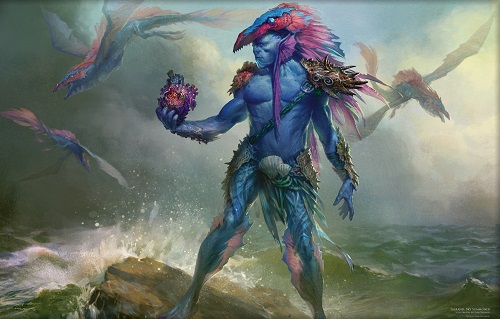
If you have a friend that wants to play mill but doesn’t have the time or money to get a big deck ready for your FNM, build this from your extras for them or trade them the pieces they need. I promise both of you will have fun, and they’ll have some stories to share!
That’s all for this week—remember to drop by next week for a turbo-charged beatdown deck, and until then, don’t forget to…uh, don’t forget…shoot, give me a second, I’ll think of it.
– Matt H
CaptainShapiro on Magic Online


